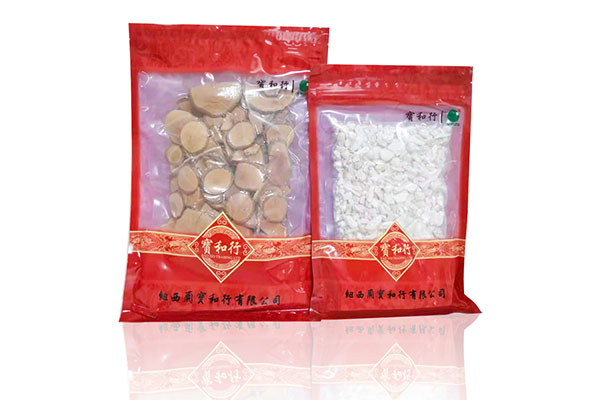Chinese herbal medicine has been around for thousands of years, and one of its most important forms is the Chinese herbal slice. If you have ever visited a traditional Chinese pharmacy or a herbal shop, you've probably seen shelves filled with neatly cut roots, stems, leaves, and flowers. These slices are the foundation of traditional formulas, and they carry not only the history of Traditional Chinese Medicine (TCM) but also its practical applications in modern life.
What Are Chinese Herbal Slices?
Chinese herbal slices are pieces of herbs that have been processed into standardized forms for easy use in formulas. They come from roots like ginseng, bark like cinnamon, fruits like goji berry, or even minerals and shells in some cases.
Traditionally, raw herbs are collected, cleaned, cut into slices, and sometimes roasted, steamed, or otherwise treated according to classic TCM texts. The purpose of slicing is simple:
● Convenience: Small slices are easier to weigh, package, and prepare.
● Consistency: Uniform size means the herbs cook evenly in decoctions.
● Preservation: Processing helps remove impurities and extend shelf life.
For example, raw astragalus root is tough and fibrous. Once sliced, it becomes manageable and ready to simmer in hot water for tea or soup.
Practical Uses: From Tea to Decoction
The real beauty of Chinese herbal slices lies in their versatility. Let's go through some of the most common ways they are used in daily life.
1. Herbal Tea: Not all herbal teas are made from tea leaves. In TCM, herbs like chrysanthemum, goji berry, licorice, and honeysuckle are often prepared as simple teas. You can put a few slices in a cup, add hot water, and let it steep. The result is a mild, drinkable infusion that supports the body in different ways.
For instance:
● Chrysanthemum tea helps cool the body and relieve eye strain.
● Goji berry slices add natural sweetness and are believed to nourish the liver and kidneys.
● Licorice slices balance other herbs and soothe the throat.
2. Decoction: The most traditional and powerful way to use Chinese herbal slices is through decoction. A decoction means simmering herbs in water for a long time, usually 30–60 minutes, so the active compounds are fully extracted. This method is commonly used for more complex prescriptions prescribed by a TCM practitioner.
3. Soup Blends: In many Chinese households, herbs are not just medicine—they are food. Herbal slices such as angelica root, Chinese yam, or red dates are often added into chicken soup or pork bone broth. This practice makes the soup both delicious and nourishing. Families often prepare these soups in winter for warmth and health.
4. Powders and Extracts: While slices are traditional, some people prefer to grind them into powder or use concentrated extracts. Still, the sliced form remains the base material for further processing, and many companies supply slices as raw materials for capsules, granules, or instant teas.
5. External Use: Not all slices are consumed. Some are boiled and used externally. For example, slices of herbs like mugwort may be boiled and used for soaking feet, believed to promote circulation and relaxation.
Why Quality of Chinese Herbal Slices Matters?
Herbal medicine is only as effective as the herbs themselves. Poor-quality slices may contain impurities, be cut unevenly, or lose their potency if not processed correctly. High-quality slices, on the other hand, follow guidelines rooted in centuries of TCM knowledge and are backed by modern production standards.
Some key factors that affect quality include:
Source of raw material: Herbs grown in their native regions often contain the best active compounds.
Harvesting time: Collecting at the right season ensures maximum potency.
Processing methods: Cutting, drying, and storage must follow traditional standards.
YIFANG: Reliable OEM Chinese Herbal Slices
When it comes to sourcing herbal slices for professional or commercial use, YIFANG stands out as a trusted manufacturer. YIFANG doesn't just sell herbs; it ensures the entire process from planting to slicing is strictly controlled.
Here's what makes YIFANG unique:
Specialized Herbal Planting Zones: YIFANG sets up specialized zones for herbal planting according to their base source. This means every herb is grown in its most suitable environment, which guarantees the best raw material.
Processing With Authority and Tradition: The company processes the slices under the guidance of Chinese authorities and according to traditional books. It helps retain the most useful parts of each herb, ensuring they stay true to their healing properties.
OEM Services: YIFANG offers OEM Chinese Herbal Slices for global partners. Whether you are a brand looking to launch your own line of herbal teas, a supplement manufacturer, or a distributor of raw TCM ingredients, YIFANG provides customized solutions.
Quality Assurance: With strict quality checks, standardized cutting, and clean packaging, YIFANG products meet the expectations of both professional practitioners and everyday consumers.
Conclusion
From tea to decoction, Chinese herbal slices have a wide range of practical uses in daily life and professional medicine.
And for businesses looking for a reliable source, YIFANG OEM Chinese Herbal Slices offer a strong solution. By focusing on planting, processing, and quality assurance, YIFANG ensures every slice delivers the true value of Chinese herbal medicine.
Whether you're sipping a light cup of chrysanthemum tea at home or formulating a professional herbal product line, it all starts with the slice—and YIFANG makes sure those slices are the best they can be.

